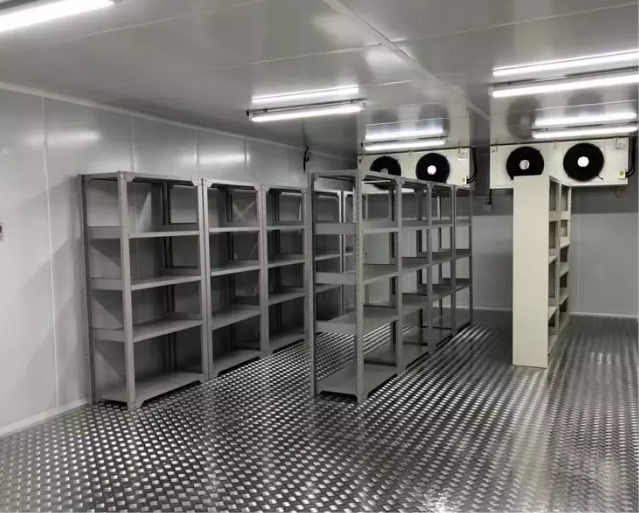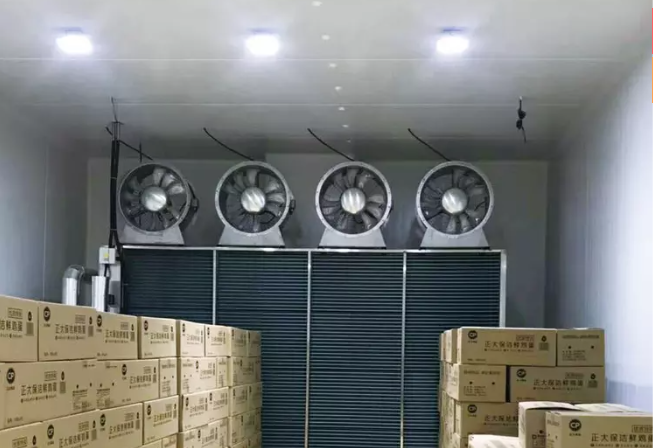Cold rooms play a vital role in maintaining the quality of perishable goods. But did you know the type of cold room you choose can make or break your business? From food storage to pharmaceuticals, various industries rely on these temperature-controlled environments.
In this post, we'll explore the different types of cold rooms and their specific applications. You'll learn how to choose the right cold room based on your business needs, ensuring optimal product preservation and compliance.

Types of Cold Rooms
Cold rooms play an essential role in various industries by preserving the quality of products through temperature control. Let’s explore the different types of cold rooms and their uses.
Chilled Storage Rooms (Positive Temperature Cold Rooms)
● Definition: These cold rooms maintain temperatures just above freezing, typically between 0-10°C.
● Common Uses: They are used for storing fruits, vegetables, dairy products, beverages, and pharmaceuticals.
● Benefits:Extends shelf life of perishable goods
○ Preserves freshness and flavor
○ Prevents spoilage and decay
Freezer Rooms (Negative Temperature Cold Rooms)
● Definition: These cold rooms maintain temperatures below freezing, usually between -18°C and -28°C.
● Common Uses: They are crucial for storing frozen foods, meats, seafood, ice cream, and some pharmaceuticals.
● Benefits:Ideal for long-term storage
○ Helps retain product integrity
○ Maintains quality during extended storage
Blast Freezers
● Definition: Blast freezers rapidly lower the temperature of products to sub-zero temperatures to prevent ice crystal formation.
● Common Uses: Often used in the food industry for freezing seafood, meats, bakery products, and in pharmaceuticals.
● Benefits:Maintains texture and quality of food
○ Reduces microbial growth
○ Prevents damage from slow freezing
Modular Cold Rooms
● Definition: Modular cold rooms consist of customizable units, allowing flexibility in size and shape.
● Common Uses: Used in industries with changing storage needs, such as pharmaceuticals, laboratories, and food services.
● Benefits:Scalable solutions for fluctuating storage needs
○ Easy to reconfigure as needed
○ Ideal for businesses with dynamic space requirements
Controlled Atmosphere (CA) Rooms
● Definition: These cold rooms not only regulate temperature but also control humidity and gas composition, such as oxygen and carbon dioxide levels.
● Common Uses: Perfect for storing fruits, vegetables, and other perishable goods that need specific environmental conditions.
● Benefits:Slows down ripening and spoilage
○ Extends the shelf life of produce
○ Allows long-term storage without loss of quality
Wine Storage Rooms (Wine Cellars)
● Definition: Wine storage rooms are specifically designed to store wine at optimal temperatures (typically between 8°C and 15°C).
● Common Uses: Used by restaurants, wineries, and retail businesses to store and age wine.
● Benefits:Maintains wine’s quality and flavor
○ Controls temperature and humidity for ideal preservation
○ Prevents wine degradation and preserves its aging potential
Summary Table of Cold Room Types
Cold Room Type | Temperature Range | Common Uses | Benefits |
Chilled Storage Rooms | 0°C to 10°C | Fruits, vegetables, dairy, pharmaceuticals | Extends shelf life, prevents spoilage |
Freezer Rooms | -18°C to -28°C | Frozen food, meats, seafood, ice cream, vaccines | Long-term storage, maintains integrity |
Blast Freezers | Below -30°C | Seafood, meats, bakery products, pharmaceuticals | Preserves texture, reduces microbial growth |
Modular Cold Rooms | Customizable | Pharmaceuticals, laboratories, food service | Scalable, adaptable to storage needs |
Controlled Atmosphere Rooms | Variable (temperature, humidity, gas) | Fruits, vegetables, perishable goods | Extends shelf life, slows ripening |
Wine Storage Rooms | 8°C to 15°C | Wine storage (restaurants, wineries, retailers) | Maintains flavor, ideal preservation |
By understanding the unique features and benefits of each type of cold room, businesses can choose the best solution for their specific storage and preservation needs.
Applications of Cold Rooms
Cold rooms are crucial in preserving various goods across multiple industries. They provide a controlled environment, ensuring that temperature-sensitive products remain fresh and viable for longer periods.
● Why cold rooms are critical: Cold rooms maintain optimal temperatures for perishable food, preventing spoilage and bacterial growth.
● Role in extending shelf life: By keeping food at the right temperature, cold rooms slow down decay, helping to preserve texture and flavor.
● Examples of food industries: Supermarkets, catering services, and food processing plants rely heavily on cold rooms to store everything from dairy to meat products.

Pharmaceutical Storage
● Preserving pharmaceutical efficacy: Cold rooms are essential for maintaining the potency of medicines, vaccines, and biologics that require strict temperature controls.
● Compliance with regulations: The pharmaceutical industry follows strict guidelines for temperature-controlled storage to ensure the effectiveness of drugs and vaccines.
● Importance of temperature control: Vaccines and certain biologics, such as insulin, must be kept within a narrow temperature range to remain effective.
Scientific Research and Laboratories
● Supporting research and experiments: Cold rooms provide stable environments for storing biological samples, chemicals, and reagents, ensuring accuracy in experiments.
● Storage of research materials: These rooms are used to keep temperature-sensitive materials, such as blood samples or cultures, in the right conditions.
● Ensuring stability: By maintaining consistent conditions, cold rooms preserve the integrity of samples, preventing errors in scientific research.
Floral Preservation
● Maintaining flower freshness: Cold rooms are key to slowing down the aging process of flowers, keeping them fresh for longer.
● Benefits for florists: Nurseries and flower distributors use cold rooms to extend the shelf life of cut flowers, allowing them to stay vibrant and attractive.
● Optimizing storage: These rooms help florists manage inventory, ensuring that flowers stay in top condition before reaching consumers.Summary Table of Cold Room Applications.
Industry | Cold Room Application | Benefits |
Food Storage | Storing fruits, vegetables, dairy, meat, and frozen foods | Extends shelf life, preserves freshness |
Pharmaceuticals | Storing vaccines, biologics, and temperature-sensitive drugs | Ensures efficacy and compliance |
Scientific Research | Storing biological samples, chemicals, and reagents | Maintains sample stability |
Floral Preservation | Storing cut flowers, plants, and nursery products | Keeps flowers fresh, extends shelf life |
This table summarizes the different applications of cold rooms across industries, highlighting how each sector benefits from controlled environments.
Benefits of Cold Rooms
Cold rooms offer various benefits to industries relying on precise storage conditions. Let’s take a look at how these temperature-controlled spaces improve product quality, efficiency, and compliance.
Product Quality Preservation
● Ensuring optimal storage conditions: Cold rooms maintain the ideal temperature and humidity levels, preserving the quality of perishable goods.
● Preventing deterioration: By controlling the environment, cold rooms prevent spoilage, loss of nutrients, and texture changes that can occur in food or pharmaceuticals.
Energy Efficiency and Cost-Effectiveness
● Modern cold room designs: Today’s cold rooms are built to minimize energy use, helping businesses lower their operational costs.
● Advanced insulation and temperature management: Features like high-quality insulation and automated temperature systems reduce energy waste, improving cost-efficiency and sustainability.
Flexibility and Customization
● Tailoring cold rooms to your needs: Cold rooms can be designed to fit specific business requirements, whether it’s adjusting the size or setting the perfect temperature range.
● Customization options: Businesses can choose cold rooms with varying storage capacities, allowing them to scale storage as needed.
Compliance with Industry Regulations
● Meeting regulatory standards: Cold rooms help businesses comply with strict guidelines in industries like food and pharmaceuticals, ensuring safe and efficient storage.
● Temperature monitoring and traceability: These rooms come with monitoring systems to track temperature fluctuations, providing necessary data for audits and ensuring regulatory compliance.
How to Choose the Right Cold Room for Your Business
Choosing the right cold room is crucial for ensuring the quality and safety of your stored products. Whether you’re in the food industry, pharmaceuticals, or another sector, understanding the key factors that influence your choice will help you make the best decision for your business.
Factors to Consider
Factor | Description |
Capacity | Consider the volume of goods you need to store. Larger businesses may need more space to accommodate their inventory. |
Temperature Requirements | Ensure the cold room’s temperature range matches your product's needs. Food, pharmaceuticals, and other goods each have unique storage needs. |
Energy Efficiency | Choose energy-efficient models to save on long-term operating costs. Modern cold rooms often come with insulation and smart temperature management systems. |
Space | Evaluate the available space for installation. Some cold rooms are modular, allowing for customizable sizes to fit your space. |
Matching Cold Room Types with Business Needs
Business Type | Cold Room Type | Key Considerations |
Food Storage | Chilled Storage or Freezer Rooms | Check temperature ranges (0°C to -28°C), volume, and frequency of access. |
Pharmaceuticals | Controlled Atmosphere or Freezer Rooms | Requires precise temperature control and strict compliance with regulations. |
Floral Preservation | Chilled Storage Rooms | Temperature control and humidity regulation are critical for maintaining freshness. |
Research/Science | Modular Cold Rooms or Freezer Rooms | Flexible sizing, precise temperature control, and space for sensitive samples. |
Cost Considerations
Cost Factor | Consideration |
Initial Investment | Different cold room types come at various price points. Modular and customized options may cost more initially. |
Long-Term Savings | Choose energy-efficient systems to reduce ongoing costs. Proper maintenance ensures the longevity of your cold room and saves money in repairs. |
Maintenance Costs | Regular maintenance is necessary to avoid breakdowns and extend the life of your cold room. Routine checks ensure that temperature control remains consistent. |
Selecting the right cold room is an investment in your business’s efficiency and product quality. By considering capacity, temperature requirements, energy efficiency, and industry-specific needs, you can choose the best cold room type for your operations.
Best Practices for Operating Cold Rooms
To maintain the efficiency and effectiveness of cold rooms, it's important to follow best practices. These practices help ensure the safety of your stored products, extend the life of refrigeration equipment, and reduce energy consumption. Here are some key strategies:
Temperature and Humidity Monitoring
Consistent monitoring of temperature and humidity is crucial for ensuring that products are stored in the right conditions. Temperature fluctuations or humidity changes can lead to spoilage or product degradation. Using automated systems with alerts for temperature deviations can help prevent these issues. When the temperature falls outside the desired range, the system will send alerts, allowing for quick action to maintain optimal storage conditions.
Inventory Management and Stock Rotation
Effective inventory management is key to reducing waste and maintaining product quality. Tracking inventory digitally helps you know exactly what you have and where it’s stored. Utilizing systems like FEFO (First Expiry, First Out) ensures that products nearing expiration are used first, reducing waste. Regular stock rotation ensures older products are used before newer ones, which helps maintain freshness and ensures that goods don't go bad before they are used.
Regular Maintenance and Inspections
Routine maintenance and inspections are essential for keeping your cold room in optimal working condition. This includes checking the refrigeration system for any issues, ensuring that temperature consistency is maintained, and verifying that there are no leaks in the cold room. Regular servicing of the refrigeration units can help prevent unexpected breakdowns, saving you from costly repairs and downtime.
Energy Management
Energy efficiency is crucial in cold room operations to keep energy costs down. Setting energy-efficient temperature levels that still ensure product safety is a good first step. Additionally, implementing modern energy-efficient technologies like advanced insulation materials, LED lighting, and energy-efficient refrigeration systems can help minimize energy consumption. Conducting regular energy audits helps
Conclusion
There are various types of cold rooms, each offering unique benefits for different industries. Choosing the right cold room is vital for preserving product quality and meeting business needs. Investing in the correct cold storage solution ensures compliance with regulations, maintains product integrity, and improves operational efficiency.
FQA
Q: What is the difference between a walk-in freezer and a cold room?
A: A walk-in freezer typically maintains temperatures below freezing, while cold rooms can store products at a wider range of temperatures, often just above freezing. Cold rooms are more flexible in use.
Q: Can cold rooms be customized to my business's needs?
A: Yes, cold rooms can be customized in terms of size, temperature range, and storage capacity to suit specific business needs, whether for food, pharmaceuticals, or research.
Q: How do I ensure my cold room meets industry regulations?
A: Ensure your cold room complies with industry standards by implementing temperature monitoring systems and maintaining precise environmental control. Regular inspections and audits also help with compliance.
Q: What are the energy-saving options for cold storage?
A: To save energy, use cold rooms with advanced insulation, LED lighting, and energy-efficient refrigeration systems. Conducting energy audits and optimizing temperature settings also helps reduce operational costs.



